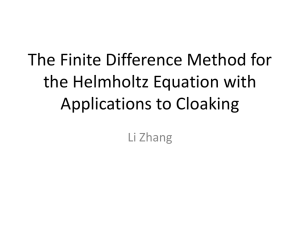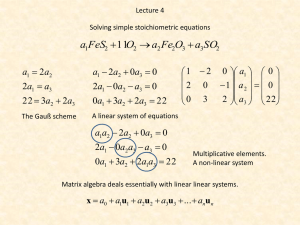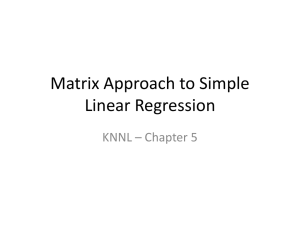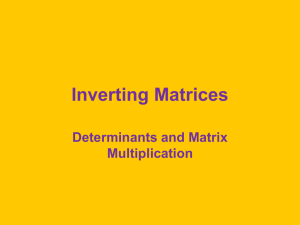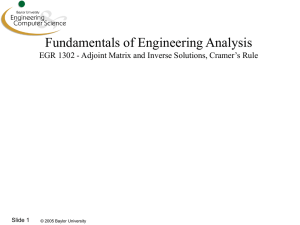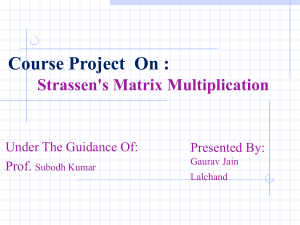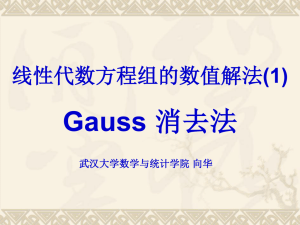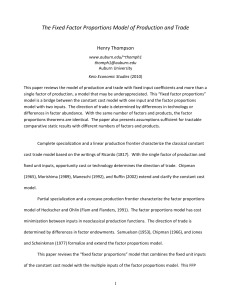Linear systems
advertisement
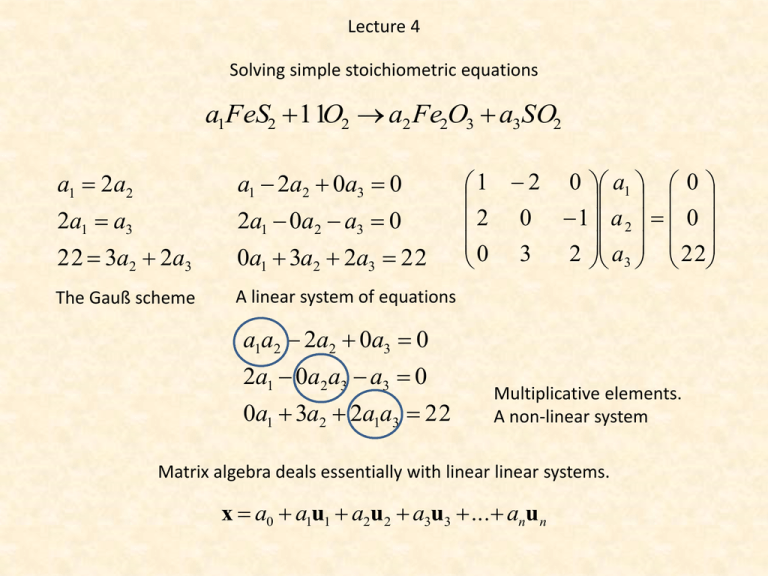
Lecture 4 Solving simple stoichiometric equations a1FeS2 11O2 a2 Fe2O3 a3SO2 a1 2a2 a1 2a2 0a3 0 2a1 a3 2a1 0a2 a3 0 22 3a2 2a3 0a1 3a2 2a3 22 The Gauß scheme A linear system of equations 1 2 0 a1 0 2 0 1 a 2 0 0 3 2 a3 22 a1a2 2a2 0a3 0 2a1 0a2 a3 a3 0 0a1 3a2 2a1a3 22 Multiplicative elements. A non-linear system Matrix algebra deals essentially with linear linear systems. x a0 a1u1 a2u2 a3u3 ... anun Solving a linear system 1 2 0 a1 0 2 0 1 a 2 0 0 3 2 a3 22 a1 0 1 2 0 a 2 0 / 2 0 1 a 22 0 3 2 3 The division through a vector or a matrix is not defined! a11 a12 b1 ; B A a a 22 21 b2 a11b1 a12b2 c1 C A B a b a b 21 1 22 2 c2 C c1 b1 a11 a12 / B c2 b2 a21 a22 c1 a11b1 a12b2 c2 a21b1 a22b2 2 equations and four unknowns Determinants 1 2 A 3 4 1 2 A 2 4 2 1 4 3 2 a A 11 a21 a12 a22 a DetA A 11 a21 0 1 4 2 2 a A d g a12 a11a22 a21a12 a22 b e h c f i Det A: determinant of A A B 1 4 3 The determinant of linear dependent matrices is zero. Such matrices are called singular. Det A 2 5 2 3 6 3 -6 Det B A 2 4 8 3 6 9 0 B 1 4 7 Det A 1 2 7 2 8 14 0 3 6 9 1 4 6 Det B 2 5 9 0 3 6 12 Higher order determinants det A (1)i j aij detSubMAij n for any i =1 to n Laplace formula j 1 1 2 3 A 2 4 6 7 8 9 4 SubMA11 8 6 2 ; SubMA12 9 7 2 3 1 ; SubMA22 SubMA21 8 9 7 2 3 1 ; SubMA32 SubMA31 4 6 2 6 2 ; SubMA13 9 7 3 1 ; SubMA23 9 7 4 8 2 8 3 1 2 ; SubMA33 6 2 4 det A 1(4 * 9 8 * 6) 2(2 * 9 7 * 6) 3(2 * 8 7 * 4) 2(2 * 9 8 * 3) 4(1* 9 7 * 3) 6(1* 2 7 * 2) 7(2 * 6 4 * 4) 8(1* 6 2 * 3) 9(1* 4 2 * 2) 0 The matrix is linear dependent The number of operations raises with the faculty of n. For a non-singular square matrix the inverse is defined as A A 1 I A 1 A I A matrix is singular if it’s determinant is zero. a A 11 a21 a12 a22 a DetA A 11 a21 Singular matrices are those where some rows or columns can be expressed by a linear combination of others. Such columns or rows do not contain additional information. They are redundant. 1 2 3 A 2 4 6 7 8 9 r2=2r1 a12 a11a22 a21a12 a22 Det A: determinant of A 1 2 3 A 4 5 6 6 9 12 r3=2r1+r2 A linear combination of vectors V k1V1 k2V2 k3V3 ... kn Vn A matrix is singular if at least one of the parameters k is not zero. The augmented matrix 1 2 3 4 5 1 2 3 4 5 Augm A 2 4 6 ; B 3 7 C ( A : B) 2 4 6 3 7 7 8 9 1 6 7 8 9 1 6 The trace of a square matrix is the sum of its diagonal entries. An insect species at three locations has the following abundances per season 1 2 3 n Trace A 2 4 6 aii 1 4 9 14 7 8 9 i 1 The diagonal entries (trace) of the dot product of AB’ contain The predation rates per the total numbers of insects season are given by per site kept by predators 0.3 0.4 0.34 0.1 10 50 60 5 B 0.2 0.25 0.25 0.05 A 34 60 74 8 0.34 0.55 0.56 0.2 25 45 48 3 43.9 29.75 66.5 C AB' 60.16 40.7 87.6 42.12 28.4 60.73 The inverse of a 2x2 matrix a A 11 a12 a21 a22 a22 1 A a11a22 a12 a21 a12 Determinant 1 a21 a11 The inverse of a square matrix only exists if its determinant differs from zero. Singular matrices do not have an inverse The inverse of a diagonal matrix a11 0 A ... 0 1 a11 0 1 A ... 0 0 0 ... ... ... ann 0 ... a22 ... ... 0 0 1 a22 ... 0 0 ... 0 ... ... 1 ... ann ... (A•B)-1 = B-1 •A-1 ≠ A-1 •B-1 The inverse can be unequivocally calculated by the Gauss-Jordan algorithm Systems of linear equations 3 x 4 y 10 2 x 5 y 12 x 10 * 5 12 * 4 3 *12 2 *10 0.285714 ; y 2.285714 3*5 2 * 4 3*5 2 * 4 Determinant a12 a11 a12 a Det 11 a11a22 a21a12 a21 a22 a21 a22 x a12 a11 x Det Det y a22 xa22 ya12 ; y a21 y a11 y a21 x ; x a12 a11a22 a21a12 a12 a11a22 a21a12 a a Det 11 Det 11 a21 a22 a21 a22 Solving a simple linear system 1 a1FeS2 11O2 a2 Fe2O3 a3SO2 1 1 2 0 1 2 0 a1 a1 a1 1 2 0 0 2 0 1 2 0 1 a 2 I a 2 a 2 2 0 1 0 0 3 2 0 3 2 a3 a3 a3 0 3 2 22 4FeS2 11O2 2Fe2O3 8SO2 The general solution of a linear system 1 0 ... 0 1 ... A 1A I Identity matrix I ... ... ... 1 XA B 0 0 ... Only possible if A is not singular. IX XI X If A is singular the system has no solution. AX B A 1AX A 1B 3x 2 y 4 z 10 3x 3 y 8 z 12 9 x 0.5 y 2.3z 1 Systems with a unique solution The number of independent equations equals the number of unknowns. 2 4 3 3 8 3 9 0.5 2.3 1 0 0 ... 1 2 4 3 3 8 3 9 0.5 2.3 X: Not singular 10 x 0.3819 12 y 4.5627 1 z 0.0678 2 4 10 3 3 8 12 3 9 0 .5 2 .3 1 The augmented matrix Xaug is not singular and has the same rank as X. The rank of a matrix is minimum number of rows/columns of the largest non-singular submatrix A matrix is linear independent if none of the row or column vectors can be expressed by a linear combinations of the remaining vectors A linear combination of vectors A k1V1 k2V2 k3V3 ... kn Vn A matrix of n-vectors (row or columns) is called linear dependent if it is possible to express one of the vectors by a linear combination of the other n-1 vectors. 1 2 3 A 2 4 6 7 8 9 r2=2r1 1 2 3 A 4 5 6 6 9 12 r3=2r1+r2 The matrices are linear dependent If a vector V of a matrix is linear dependent on the other vecors, V does not contain additional information. It is completely defined by the other vectors. The vector V is redundant. k1V1 k2 V2 k3V3 ... kn Vn k1V1 k2 V2 k3V3 ... kn Vn 0 k1 , k2 , k3 ...kn 0 Linear independence How to detect linear dependency k 1 0 2 3 1 2k1 3k 2 1k3 0 2k1 4k 2 6(2k1 3k 2 ) 0 10k1 14k 2 0 190 A 2 4 6 2k1 4k 2 6k3 0 11k1 k1 0 k 2 0 7 k 8 k 9 ( 2 k 3 k ) 0 11 k 19 k 0 14 1 2 1 2 1 2 7 8 9 7k 8k 9k 0 k3 0 1 2 3 k 1 2k 2 k 2k 6k1 12k 2 k1 2k 2 7k3 0 1 2 3 2k1 4k 2 8( 1 2 ) 0 0 k 2 k 0 k 2 7 7 7 A 2 4 6 2k1 4k 2 8k3 0 7 1 k2 1 k 2k 12k1 24k 2 2 7 8 9 3k 6k 9k 0 3k1 6k 2 9( 1 2 ) 0 0 k1 2k 2 0 k 0 1 2 3 3 7 7 7 7 Any solution of k3=0 and k1=-2k2 satisfies the above equations. The matrix is linear dependent. If a matrix A is linearly independent, then any submatrix of A is also linearly independent The rank of a matrix is the maximum number of linearly independent row and column vectors 1 2 3 1 2 3 RankA 2 4 6 2 RankA 4 5 6 2 7 8 9 6 9 12 1 2 3 4 2 4 6 8 RankA 1 4 8 12 16 8 16 24 32 a1 2a 2 a 3 2a 4 5 2a1 3a 2 2a 3 3a 4 6 3a1 4a 2 4a 3 3a 4 7 5a1 6a 2 7a 3 8a 4 8 2x1 6x 2 5x 3 9x 4 10 2 2x1 5x 2 6x 3 7x 4 12 2 4x1 4x 2 7x 3 6x 4 14 4 5x1 3x 2 8x 3 5x 4 16 5 2x1 3x 2 4x 3 5x 4 10 2 4x1 6x 2 8x 3 10x 4 20 4 4x1 5x 2 6x 3 7x 4 14 4 5x1 6x 2 7x 3 8x 4 16 5 6 5 5 6 4 7 3 8 3 9 x1 7 x2 6 x3 5 x4 4 10 12 14 16 x1 x2 7 x3 8 x4 5 Infinite number of 6solutions 8 10 5 6 6 7 3 No solution 6 4 8 5 6 6 7 2x1 3x 2 4x 3 5x 4 10 2 4x1 6x 2 8x 3 10x 4 12 4 4x1 5x 2 6x 3 7x 4 14 4 5x1 6x 2 7x 3 8x 4 16 5 2x1 3x 2 6x 3 9x 4 10 2 2x1 4x 2 5x 3 6x 4 12 2 4x1 5x 2 4x 3 7x 4 14 4 3 5 x1 10 x 2 7 x3 8 x4 10 20 14 16 10 12 14 16 x1 9 10 x2 5 6 12 x3 14 4 7 x 4 3 4 5 10 x1 12 6 8 10 x2 14 5 6 7 x3 6 7 8 16 x 4 16 12 14 16 6 Infinite number of4 solutions 5 2x1 3x 2 4x 3 5x 4 10 2 4x1 6x 2 8x 3 10x 4 12 4 4x1 5x 2 6x 3 7x 4 14 4 5 5x1 6x 2 7x 3 8x 4 16 10x1 12x 2 14x 3 16x 4 16 10 No solution 2x1 3x 2 4x 3 5x 4 10 2 4x1 6x 2 8x 3 10x 4 12 4 4x1 5x 2 6x 3 7x 4 14 4 5 5x1 6x 2 7x 3 8x 4 16 10x1 12x 2 14x 3 16x 4 32 10 3 4 6 8 5 6 6 12 7 14 Infinite number of solutions 5 x1 10 x2 7 x3 8 x 4 16 10 12 14 16 32 Consistent Rank(A) = rank(A:B) = n Consistent Rank(A) = rank(A:B) < n Inconsistent Rank(A) < rank(A:B) Consistent Rank(A) = rank(A:B) < n Inconsistent Rank(A) < rank(A:B) Consistent Rank(A) = rank(A:B) = n A X B A 1 A X A 1 B X A 1 B Consistent system Solutions extist rank(A) = rank(A:B) Single solution extists rank(A) = n Inconsistent system No solutions rank(A) < rank(A:B) Multiple solutions extist rank(A) < n n1KOH n2Cl2 n3 KClO3 n4 KCl n5 H 2O n1 n3 n4 n1 n3 n4 0 n1 3n3 n5 n1 3n3 n5 n1 2n5 n1 2n5 2n2 n3 n4 2n2 n3 n4 0 We have only four equations but five unknowns. The system is underdetermined. n1 1 1 1 0 Inverse 0 -0.5 0 -1 n2 0 0 0 2 n3 -1 -3 0 -1 0 1 0 0.5 -0.33333 0.333333 0.333333 0.666667 1 1 1 0 n4 -1 0 0 -1 0 0.5 0 0 1 1 n1 0 0 3 0 n2 1 n5 0 0 0 n3 2 2 1 1 n4 0 0 A 0 1 2 0 N*n5 2 1 0.333333 1.666667 n1 n2 n3 n4 n5 6 3 1 5 3 The missing value is found by dividing the vector through its smallest values to find the smallest solution for natural numbers. 6KOH 3Cl2 KClO3 5KCl 3H 2O n1Mga1Sia 2 n2 Na3 H a 4Bra5 n3Sia6 H a7 n4 Na8 H a9 n5 Mga10 Bra11 Equality of atoms involved n1a1 n5 a10 n1a2 n3 a6 n2 a3 n4 a8 n2 a4 n4 a9 n3 a7 n2 a5 n5 a11 Including information on the valences of elements a1 2a2 a4 a3 a5 a7 4 a 6 a8 4(a9 1) a10 2a11 We have 16 unknows but without experminetnal information only 11 equations. Such a system is underdefined. A system with n unknowns needs at least n independent and non-contradictory equations for a unique solution. a1 a11 If ni and ai are unknowns we have a non-linear situation. We either determine ni or ai or mixed variables such that no multiplications occur. n1a1 n5 a10 n1a2 n3 a6 n2 a3 n4 a8 n2 a4 n4 a9 n3 a7 n2 a5 n5 a11 a1 2a2 a4 a3 a5 a7 4 a 6 a8 4(a9 1) a10 2a11 a1 a11 0 n1 0 0 0 0 n1 0 0 0 0 n3 0 0 n2 0 0 0 0 0 0 0 n2 0 0 0 0 0 n2 0 2 1 0 0 0 0 0 0 1 1 1 0 0 0 0 0 0 4 0 0 0 0 0 0 0 0 0 0 0 0 0 1 0 0 0 0 0 0 0 n5 0 a1 0 0 0 0 0 0 a 2 0 0 0 n4 0 0 a3 0 0 n3 0 n4 0 a 4 0 0 0 0 0 n5 a5 0 0 0 0 0 0 a6 0 0 0 0 0 0 a7 0 1 0 0 4 0 a8 0 0 1 4 0 0 a9 4 0 0 0 1 2 a10 0 0 0 0 0 1 a11 0 The matrix is singular because a1, a7, and a10 do not contain new information Matrix algebra helps to determine what information is needed for an unequivocal information. n1Mga1Sia 2 n2 Na3 H a 4Bra5 n3Sia6 H a7 n4 Na8 H a9 n5 Mga10 Bra11 From the knowledge of the salts we get n1 to n5 n1Mga1Sia 2 n2 Na3 H a 4Bra5 n3Sia6 H a7 n4 Na8 H a9 n5 Mga10 Bra11 Mg2 Si 4Na3 H a 4Bra5 SiHa7 4Na8 H a9 2MgBr2 a4 3a3 a5 a3 a8 4 a 4 a 7 4 a9 4a5 4 a8 1 a9 3 3 1 0 0 0 0 1 1 0 0 4 0 0 1 0 0 0 0 a3 a4 a5 a7 a8 a9 Inverse 0 a3 0 0 1 0 a4 0 1 0 4 a5 0 0 0 0 a7 1 0 1 0 a8 1 0 0 1 a9 3 0 0 We have six variables and six equations that are not contradictory and contain different information. The matrix is therefore not singular. a3 -3 1 0 0 0 0 a4 1 0 4 0 0 0 a5 -1 0 0 1 0 0 a7 0 0 -1 0 0 0 a8 0 -1 0 0 1 0 a9 0 0 -4 0 0 1 0 1 0 4 0 0 1 3 0 12 0 0 0 0 0 -1 0 0 0 1 1 4 0 0 1 3 0 12 1 0 0 0 0 -4 0 1 A 0 0 0 1 1 3 a3 a4 a5 a7 a8 a9 Mg2 Si 4NH 4Br SiH4 4NH 3 2MgBr2 1 4 1 4 1 3 Linear models in biology The logistic model of population growth r 2 N rN N c K t 1 2 3 4 N 1 5 15 45 We need four measurements r 4 1r 1 c K r 10 5r 25 c K r 30 15r 225 c K 1 1 r 4 1 10 5 15 1 r / K 30 15 225 1 c K denotes the maximum possible density under resource limitation, the carrying capacity. r denotes the intrinsic population growth rate. If r > 1 the population growths, at r < 1 the population shrinks. K 1.286 / 0.036 36 Population growth N 1.286 N t 1 2 3 4 5 6 7 8 9 10 1.286 2 N 2.679 36 N 1 4.928571 13.07635 26.46055 38.15409 37.8974 38.00788 37.96091 37.98099 37.97242 N 3.928571 8.147777 13.3842 11.69354 -0.25669 0.110482 -0.04698 0.02008 -0.00856 0.003656 We have an overshot. In the next time step the population should decrease below the carrying capacity. N K Overshot K/2 N (t 1) N (t ) N (t ) N (t 1) N 1.286N 1.286 2 N 2.679 36 Fastest population growth t

